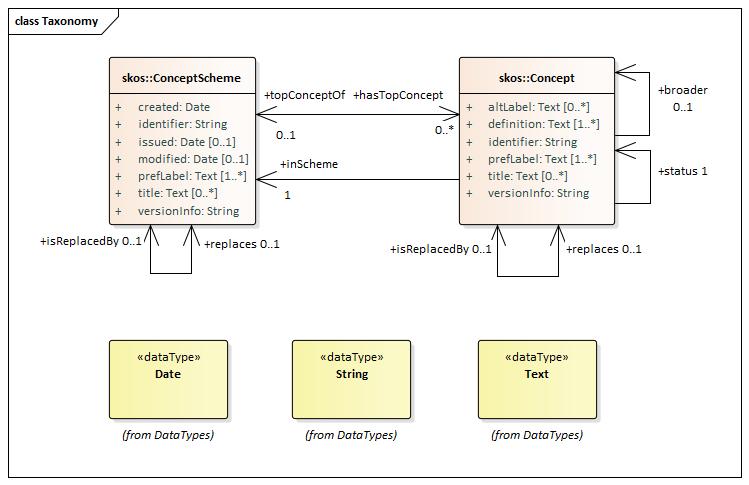| Concept |
http://www.w3.org/2004/02/skos/core#Concept |
|
alternative label |
http://www.w3.org/2004/02/skos/core#altLabel |
| Concept |
http://www.w3.org/2004/02/skos/core#Concept |
|
definition |
http://www.w3.org/2004/02/skos/core#definition |
| Concept |
http://www.w3.org/2004/02/skos/core#Concept |
|
has broader |
http://www.w3.org/2004/02/skos/core#broader |
| Concept |
http://www.w3.org/2004/02/skos/core#Concept |
|
identifier |
http://purl.org/dc/terms/identifier |
| Concept |
http://www.w3.org/2004/02/skos/core#Concept |
|
is in scheme |
http://www.w3.org/2004/02/skos/core#inScheme |
| Concept |
http://www.w3.org/2004/02/skos/core#Concept |
|
is replaced by |
http://purl.org/dc/terms/isReplacedBy |
| Concept |
http://www.w3.org/2004/02/skos/core#Concept |
|
is top concept of |
http://www.w3.org/2004/02/skos/core#topConceptOf |
| Concept |
http://www.w3.org/2004/02/skos/core#Concept |
|
preferred label |
http://www.w3.org/2004/02/skos/core#prefLabel |
| Concept |
http://www.w3.org/2004/02/skos/core#Concept |
|
replaces |
http://purl.org/dc/terms/replaces |
| Concept |
http://www.w3.org/2004/02/skos/core#Concept |
|
status |
http://publications.europa.eu/ontology/euvoc#status |
| Concept |
http://www.w3.org/2004/02/skos/core#Concept |
|
title |
http://purl.org/dc/terms/title |
| Concept |
http://www.w3.org/2004/02/skos/core#Concept |
|
version info |
http://www.w3.org/2002/07/owl#versionInfo |
| Concept Scheme |
http://www.w3.org/2004/02/skos/core#ConceptScheme |
|
date created |
http://purl.org/dc/terms/created |
| Concept Scheme |
http://www.w3.org/2004/02/skos/core#ConceptScheme |
|
date issued |
http://purl.org/dc/terms/issued |
| Concept Scheme |
http://www.w3.org/2004/02/skos/core#ConceptScheme |
|
date modified |
http://purl.org/dc/terms/modified |
| Concept Scheme |
http://www.w3.org/2004/02/skos/core#ConceptScheme |
|
has top concept |
http://www.w3.org/2004/02/skos/core#hasTopConcept |
| Concept Scheme |
http://www.w3.org/2004/02/skos/core#ConceptScheme |
|
identifier |
http://purl.org/dc/terms/identifier |
| Concept Scheme |
http://www.w3.org/2004/02/skos/core#ConceptScheme |
|
is replaced by |
http://purl.org/dc/terms/isReplacedBy |
| Concept Scheme |
http://www.w3.org/2004/02/skos/core#ConceptScheme |
|
preferred label |
http://www.w3.org/2004/02/skos/core#prefLabel |
| Concept Scheme |
http://www.w3.org/2004/02/skos/core#ConceptScheme |
|
replaces |
http://purl.org/dc/terms/replaces |
| Concept Scheme |
http://www.w3.org/2004/02/skos/core#ConceptScheme |
|
title |
http://purl.org/dc/terms/title |
| Concept Scheme |
http://www.w3.org/2004/02/skos/core#ConceptScheme |
|
version info |
http://www.w3.org/2002/07/owl#versionInfo |

![[o]](html/callout.png)